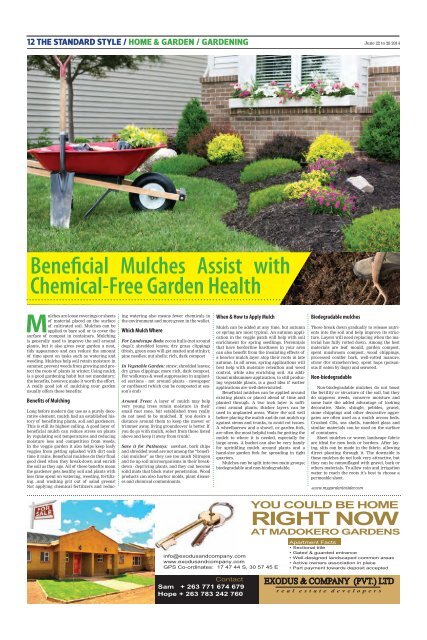The Standard 22 June 2014
You also want an ePaper? Increase the reach of your titles
YUMPU automatically turns print PDFs into web optimized ePapers that Google loves.
12 THE STANDARD STYLE / HOME & GARDEN / GARDENING<br />
<strong>June</strong> <strong>22</strong> to 28 <strong>2014</strong><br />
Beneficial Mulches Assist with<br />
Chemical-Free Garden Health<br />
Mulches are loose coverings or sheets<br />
of material placed on the surface<br />
of cultivated soil. Mulches can be<br />
applied to bare soil or to cover the<br />
surface of compost in containers. Mulching<br />
is generally used to improve the soil around<br />
plants, but it also gives your garden a neat,<br />
tidy appearance and can reduce the amount<br />
of time spent on tasks such as watering and<br />
weeding. Mulches help soil retain moisture in<br />
summer, prevent weeds from growing and protect<br />
the roots of plants in winter. Using mulch<br />
is a good gardening habit but not mandatory;<br />
the benefits, however, make it worth the effort.<br />
A really good job of mulching your garden<br />
usually offers these benefits:<br />
Benefits of Mulching<br />
Long before modern day use as a purely decorative<br />
element, mulch had an established history<br />
of benefitting plants, soil and gardeners.<br />
This is still its highest calling. A good layer of<br />
beneficial mulch can reduce stress on plants<br />
by regulating soil temperatures and reducing<br />
moisture loss and competition from weeds.<br />
In the veggie garden it also helps keep leafy<br />
veggies from getting splashed with dirt each<br />
time it rains. Beneficial mulches do their final<br />
good deed when they break-down and enrich<br />
the soil as they age. All of these benefits mean<br />
the gardener gets healthy soil and plants with<br />
less time spent on watering, weeding, fertilizing…and<br />
washing grit out of salad greens!<br />
Not applying chemical fertilizers and reducing<br />
watering also means fewer chemicals in<br />
the environment and more green in the wallet.<br />
Which Mulch Where<br />
For Landscape Beds: cocoa hulls (not around<br />
dogs!); shredded leaves; dry grass clippings<br />
(fresh, green ones will get matted and stinky);<br />
pine needles; nut shells; rich, dark compost<br />
In Vegetable Garden: straw; shredded leaves;<br />
dry grass clippings; more rich, dark compost.<br />
For walkways & weed suppression in unplanted<br />
sections - not around plants - newspaper<br />
or cardboard (which can be composted at season’s<br />
end)<br />
Around Trees: A layer of mulch may help<br />
very young trees retain moisture in their<br />
small root zone, but established trees really<br />
do not need to be mulched. If you desire a<br />
distance around them to keep the mower or<br />
trimmer away, living groundcover is better. If<br />
you do go with mulch, select from those listed<br />
above and keep it away from trunk!<br />
Save it for Pathways: sawdust, bark chips<br />
and shredded wood are not among the “beneficial<br />
mulches” as they use too much Nitrogen<br />
and tie up soil microorganisms in their breakdown<br />
- depriving plants, and they can become<br />
solid mats that block water penetration. Wood<br />
products can also harbor molds, plant diseases<br />
and chemical contaminants.<br />
When & How to Apply Mulch<br />
Mulch can be added at any time, but autumn<br />
or spring are most typical. An autumn application<br />
in the veggie patch will help with soil<br />
enrichment for spring seedlings. Perennials<br />
that have borderline hardiness in your area<br />
can also benefit from the insulating effects of<br />
a heavier mulch layer atop their roots in late<br />
autumn. In all areas, spring applications will<br />
best help with moisture retention and weed<br />
control, while also enriching soil. An additional<br />
midsummer application, to still producing<br />
vegetable plants, is a good idea if earlier<br />
applications are well-deteriorated.<br />
Beneficial mulches can be applied around<br />
existing plants or placed ahead of time and<br />
planted through. A two inch layer is sufficient<br />
around plants; thicker layers can be<br />
used in unplanted areas. Water the soil well<br />
before placing the mulch and do not mulch up<br />
against stems and trunks, to avoid rot issues.<br />
A wheelbarrow and a shovel, or garden fork,<br />
are often the most helpful tools for getting the<br />
mulch to where it is needed, especially for<br />
large areas. A bucket can also be very handy<br />
for sprinkling mulch around plants and a<br />
hand-size garden fork for spreading in tight<br />
quarters.<br />
Mulches can be split into two main groups;<br />
biodegradable and non-biodegradable.<br />
Biodegradable mulches<br />
<strong>The</strong>se break down gradually to release nutrients<br />
into the soil and help improve its structure.<br />
Layers will need replacing when the material<br />
has fully rotted down. Among the best<br />
materials are leaf mould, garden compost,<br />
spent mushroom compost, wood chippings,<br />
processed conifer bark, well-rotted manure,<br />
straw (for strawberries), spent hops (poisonous<br />
if eaten by dogs) and seaweed.<br />
Non-biodegradable<br />
Non-biodegradable mulches do not boost<br />
the fertility or structure of the soil, but they<br />
do suppress weeds, conserve moisture and<br />
some have the added advantage of looking<br />
decorative. Slate, shingle, pebbles, gravel,<br />
stone chippings and other decorative aggregates<br />
are often used as a mulch across beds.<br />
Crushed CDs, sea shells, tumbled glass and<br />
similar materials can be used on the surface<br />
of containers.<br />
Sheet mulches or woven landscape fabric<br />
are ideal for new beds or borders. After laying,<br />
slits can be made in the fabric, allowing<br />
direct planting through it. <strong>The</strong> downside is<br />
these mulches do not look very attractive, but<br />
they can be camouflaged with gravel, bark or<br />
others materials. To allow rain and irrigation<br />
water to reach the roots it’s best to choose a<br />
permeable sheet.<br />
-www.mygardeninsider.com<br />
info@exodusandcompany.com<br />
www.exodusandcompany.com<br />
GPS Co-ordinates: 17 47 44 S, 30 57 45 E<br />
YOU COULD BE HOME<br />
RIGHT NOW<br />
AT MADOKERO GARDENS<br />
Apartment Facts<br />
• Sectional title<br />
• Gated & guarded entrance<br />
• Well-designed landscaped common areas<br />
• Active owners association in place<br />
• Part payment towards deposit accepted<br />
Contact<br />
Sam + 263 771 674 679<br />
Hope + 263 783 242 760<br />
EXODUS & COMPANY (PVT.) LTD<br />
real estate developers


















